How to Plan a Novel Study Step-by-Step
If you’ve been teaching with a reading textbook or basal reader, the idea of guiding your readers through an entire novel unit can be overwhelming at first. Add planning your first novel study to the mix, and it can be enough to dissuade even veteran educators. However, incorporating novels and chapter books into your reading instruction doesn’t have to be scary or stressful.

Today I want to share the steps I use to plan my novel studies. I’ll walk you through the process step-by-step and show you approachable strategies for getting started.
I’ll also share a free novel study planning roadmap I created to help you plan for your novel study.
What is a novel study?
Before we dive into planning your first novel study, it is essential to make sure we’re on the same page regarding what a novel study is…and isn’t.

First off, a novel study is NOT a way to effectively teach phonics and decoding.
Younger or struggling readers will also need explicit, sequential phonics instruction to continue building their word attack and decoding skills.
In addition, a novel study is NOT teaching a book.
We aren’t quizzing kids on what happened on page 54. We don’t need them to just be able to regurgitate the text. A novel study is so much more than that.
The reality of the situation is we should always center our focus around the fact we teach kids. A novel study allows those kids to develop their reading comprehension and thinking skills through high-quality literature. It lets them practice and refine their skills related to the standards in a much more engaging format than the typical reading textbook.
A novel study is an opportunity to build a love of reading.
When done as a whole group, it can create a shared experience that builds communities and creates connections.
And with the right text, it can help the skills and strategies you’ve been teaching your readers become tangible.
What is the purpose of a novel study?
There is no single purpose for doing novel studies in the classroom. In fact, the purpose of the novel studies you do may differ across the year.
That being said, it is important to understand why novel studies are a common practice in many classrooms.
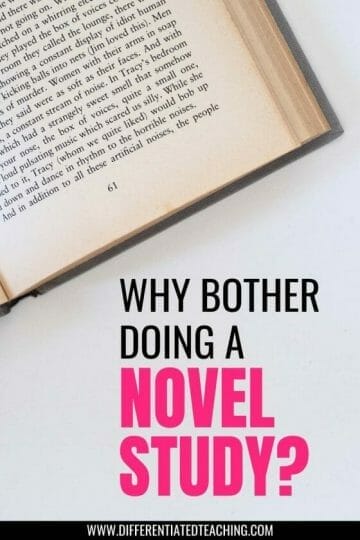
There are so many great benefits of using novel studies in your classroom. For starters, a literature-rich curriculum has been shown to improve reading and writing skills (Fook & Sidhu, 2010).
Novel studies can also expose students to perspectives or experiences. They help readers visualize and develop an understanding of things that have never happened in their lives. Even when a novel covers a familiar experience, it often offers a different perspective.
Conversations about reading can also be a tool for building students’ abilities to carry on an intellectual discussion with peers and develop social and communication skills.
That said, novel studies take a significant amount of time. To make them successful, it’s important to approach them with purpose and planning.
Planning Your First Novel Study: A How-to-Guide
Now that we’re on the same page with the background information, it’s time to dig into the steps to planning a novel study.
I’ll break down each step below, but here’s the general overview:
- #1 – Set your purpose.
- #2 – Identify target standards.
- #3 – Pick a framework & texts.
- #4 – Determine your timeline.
- #5 – Map your unit.
If you’re all about action, grab my Free Novel Study Planning Roadmap. That way, you can start working through the process right away!
Step 1: Set your purpose.
This step is really about making sure you’re focused on backward design. When you started considering a novel study for your class, you had a purpose. If you aren’t sure, consider asking yourself some questions –
- Why did you decide this might be the next logical step in your instruction?
- When you finish this unit, what are you expecting your students to know or be able to do?
- What are you hoping students will carry into the real world?
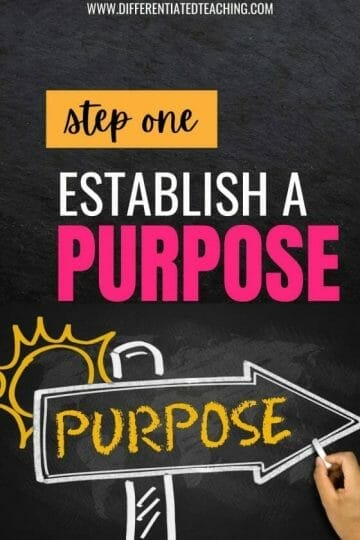
Sometimes this will relate to a few core comprehension standards. However, you’ll often find that your novel study serves a larger purpose.
Maybe you’re introducing students to the characteristics of a specific genre.
You might also use a novel study to introduce a historical period or event you discuss in social studies.
Regardless of whether your purpose has cross-curricular connections or is singularly focused on a specific reading component, you must begin with the end in mind by defining this goal.
Step 2: Identify target standards.
Now that you’ve identified why you’re doing a novel study, it’s time to focus on the standards.
This is where you’ll begin creating your plan of action, which you’ll dive into throughout the next few steps.
One benefit of novel studies is the ability to connect multiple standards. That said, we all know that some standards could use extra attention.
Summary, for example, often gives students a hard time, and it is also a great skill to address through the lens of a novel.
As you work through this step, look at your recent reading data and identify 2-3 standards that have been particularly troublesome for your class.
These will be the standards you aim to address 2-3 times throughout your text.

You should also keep these steps in mind as you begin to consider the books you select and how you’ll organize your student groups.
Step 3: Select your framework & text(s).
So far, you’ve focused on the big picture, considered your novel study’s purpose, and outlined the core standards you need to pay extra attention to. With these things in mind, you can start digging into the details.
It’s time to choose your texts and the framework for organizing your study. You can either start by selecting specific books for students to read or focus on grouping them first. Both approaches are effective, but complete this step before moving on to the next phase.
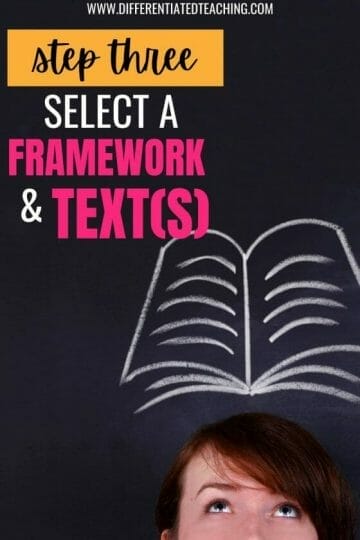
Here’s what I mean. If you’re trying to build a shared background understanding of a historical period, you may want to do a whole class novel study with lots of conversation.
If you’re delving into the complexities of friendships and their impact on characters, consider using book clubs. This approach allows students to share their personal insights and lessons learned from their reading experiences.
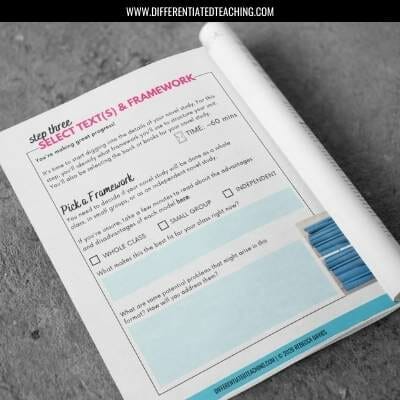
For example, a whole-class novel study might not be the best fit if your students have varied reading levels or must meet different standards. In this post, we will look at various ways to organize student groups.
Common Novel Study Formats in the Classroom
Not surprisingly, most novel studies are done in one of three formats. These are:
- Whole-Class or Whole-Group Novel Study
- Small-Group Novel Study – Literature Circles or Book Clubs
- Independent Novel Study
Each format offers positives and negatives, so you may find that your students end up experiencing all three across the course of a school year. The most important thing is that the format you select aligns with your set purpose and can be used to address the target standards.
Knowing that, let’s examine the advantages and disadvantages of group and independent reading by breaking down each format.
Whole-Class Novel Studies

In a whole-class novel study, everyone reads the same book. Each student has their own copy and can choose to read out loud. This approach differs from a read-aloud, which is more about listening and enjoying the story. Here, students actively read and see the words.
During the reading, the class might pause for discussions. You can use extra materials like movie clips or news articles to enrich these talks or demonstrate thinking processes.
After reading, students often write their thoughts or summaries. For longer texts, some independent reading may be done to finish the chapter.
This format usually follows a pattern: read, discuss, respond. Students read together, discuss as a group, and then write independently to reflect on their thoughts.
The key aspect of a whole-class novel study is that all students work with the same standards, text, and additional resources.
Advantages of Whole-Class Novel Studies
- Builds community and provides a shared experience to hook later lessons upon
- Easier for the teacher to plan and monitor – makes it great for beginners
- Can serve as an invitation to help students discover a new series or genre of book.
- Provides opportunities for struggling or reluctant readers to engage in rigorous discussions about literature and access lessons on the same higher-level comprehension skills as peers.
- Allows all readers to access the same culturally relevant or meaningful texts.
Disadvantages of Whole-Class Novel Studies
- Easy to incorporate ineffective/harmful practices – like round-robin reading.
- It is harder to encourage equal participation – reluctant learners may sit back and allow peers to dominate the discussion.
- Too often, it becomes one-size-fits-all teaching without differentiation in the novel study activities.
Small-Group Novel Studies – Literature Circles/ Book Clubs
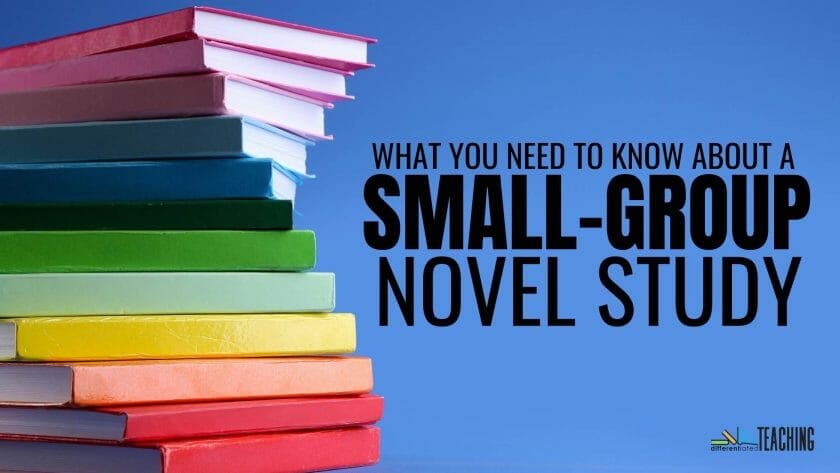
If you’ve got children at various readiness levels or a large class, you may decide that small groups would work better for your novel study.
With a small group novel study, each group has its own text. They may be working on the same skills as other groups or a different set of skills.
The small group reads together and discusses daily reading. Roles are often used to help manage the group’s time together.
After finishing, students may complete a reflection or respond to a question that connects to the discussion.
Advantages of Small Group Novel Studies
- Excellent for supporting social skills and student conversations
- Offers opportunities to explore a theme or idea from numerous perspectives.
- Allows students to have a text that is more accessible to them w/ peers at the same general reading level.
- Each group can have tasks tailored to their individual needs.
- It provides a semi-structured opportunity for students to take charge of their learning
Disadvantages of Small Group Novel Studies
- Groups can be challenging for teachers – not ideal for beginners.
- Requires planning for several novels and the ability to monitor and support different groups of learners simultaneously.
- Groups can quickly get off task or off-track in their discussions without an adult monitor.
- Missed teaching opportunities while circulating among groups.
- Difficult to unify pacing so all groups are ready to move on to a new unit at the same time.
Independent Novel Studies

In this format, students complete a novel study independently or with one-on-one instruction from a teacher or guide.
With an independent novel study, each student has a different text based on their own interests or needs. They read independently (or with the teacher) and then work to respond to literature.
Mini-lessons may be provided to small groups working on the same skill, but the student works independently overall.
Advantages of Doing Independent Novel Studies
- Offers each student a chance to find a book that piques their interest.
- Great for classes with students with diverse interests or skill levels.
- Promotes independent study skills and puts students in control of their own learning.
- Great for advanced learners or as a way to engage early finishers in an extended project.
- Removes element of comparison between peers
- Can be done on a student-by-student basis to supplement the curriculum
- Offers students near mastery the opportunity to apply comprehension skills
Disadvantages of Independent Novel Studies
- Large amounts of planning & prep
- Requires the teacher to read and be familiar with multiple texts.
- Not for struggling, reluctant, or unmotivated learners unless done one-on-one.
- Not ideal for instruction – designed more for practice/skill application
Selecting Text for Your Novel Study Activities
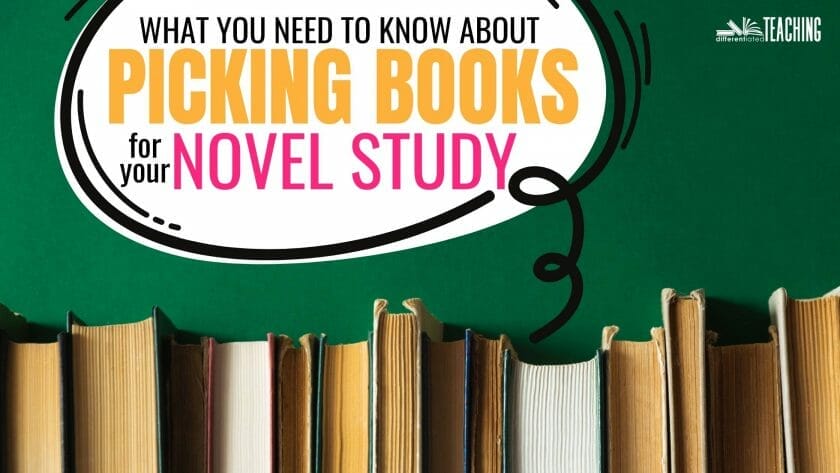
Since we’ve spent some time outlining the different frameworks you might select for your novel study, I’ll use this section to outline how you’ll select your texts.
Please know that I recommend reading any novels you plan to use in classroom novel studies before you make your selections.
However, I know this isn’t always feasible. Therefore, at a bare minimum, you should look at the synopsis and some reviews online to ensure you don’t end up surprised by some unexpected content or language.
The last thing you want is to expose students to something they aren’t ready to deal with an angry parent or administrator over your novel selection.
That being said, when it comes to picking your novels, you’ll find many different ideas about how to make your decisions.
Quite honestly, much of the decision comes down to your goal and classroom situation, and you’ll likely find no two years are alike.
The great news is that novel study is meant for flexibility. Given the current status of online learning, you may want to select texts that are available digitally, such as those from platforms like Epic.
(Don’t worry; I’ll be sharing more about how to adjust a novel study for digital learning soon.)
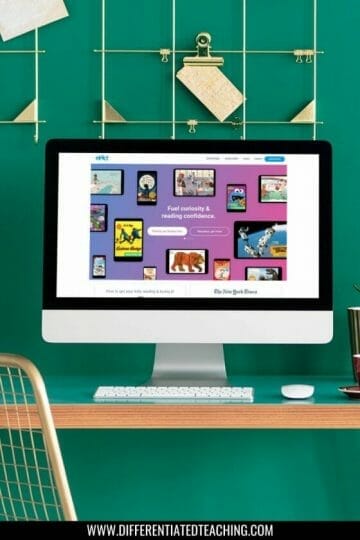
For those of you doing in-person learning, you might also consider whether you’ve got enough copies of a book available on your campus before you select it. If you need ideas for places to find inexpensive class sets of books, check out my post about ways to build your classroom library on a budget.
You’ll also want to consider your students’ current abilities. Selecting a book that is too difficult or too simple can cause students to disengage.
While many conversations are held about the importance of picking a book at the right level for your readers, the reading level is only a small part of what you need to consider.

You’ll also want to consider your students’ background experiences, interests, and passions. For example, selecting a book about a group of teenage girls trying to make the dance team may not be the best choice for your football-loving preteen boys. You’ve got to consider the audience you’re hoping to reach.
Research has shown that students prefer books that reflect some aspect of their lived experience (Ghani, 2009). Texts that discuss the social and relationship issues that arise during youth are also great choices for building connections.
The appropriateness of the content is also critical. That said, this can be a bit more challenging when you have a young reader with advanced skills or an older reader who struggles.
To help you get started, I’ve included a list of 100 popular novels in the free guide. Your school or local librarian can also be a great person to connect with to get suggestions.
Step 4: Create your timeline.
Now that you’ve established your foundation, you’ll want to create a timeline and plan how you’ll assess student understanding.
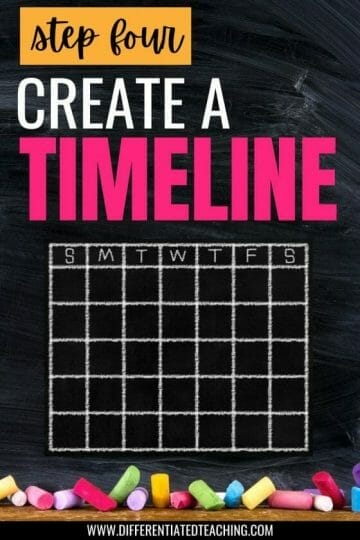
When I consider how long a novel study should take, I consider the time I’ll be able to devote to the book each day and any scheduling concerns (like extended breaks).
As a personal preference, I try to break the novel evenly into weeks beginning on a Monday and ending on a Friday. While we may have pre-reading activities or post-reading activities that fall outside that window, I find that planning using a weekly calendar makes things easier to manage.
I’ve included a planning table in the free Novel Study Roadmap to help you as you begin planning.
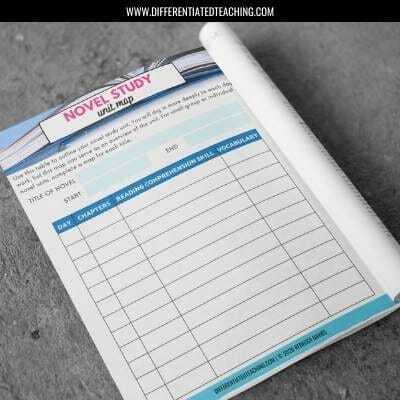
I also like to consider the book or books I’m using in my novel study. Longer novels typically require longer units. I don’t want to rush so much that we miss opportunities for conversation and learning. However, I also don’t want to drag it out if the text is short.
By creating a general timeline, I can see how best to break the novel into digestible chunks and where each of the standards I identified in step 2 would best fit.
Step 5: Map Your Unit Plan for the Perfect Novel Study
We’re finally here!! Mapping your first novel study is the final step before you can implement it.
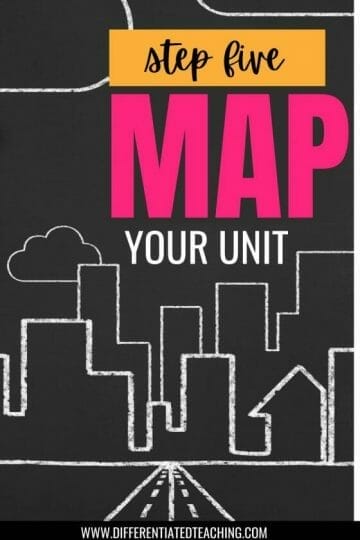
At this stage, you’re digging into the meat of your novel study. You’ll find that my approach to the mapping process may be a bit different from that of other novel study advocates. For me, two significant components to consider while mapping are comprehension skills and vocabulary.
I personally advocate that you focus on one comprehension skill each day.
As I said earlier, we teach kids, not books. There is no reason I should ask a student to sit down and respond to 10 questions about the two chapters they read.
Instead, I’d prefer to ask them ONE question that really gets them to apply the comprehension strategy and their own thoughts and ideas to better understand the text.
When I conduct a novel study, this format allows me to provide more targeted instruction and focus on building mastery versus surface level. My experience has been that it makes it easier for students to take that skill and apply it later.
I also recommend limiting the number of vocabulary words you study in depth. You’ll want to cover both academic and text-based vocabulary, but I tend to stick with one word for in-depth study each day.
I’ll discuss the specifics a bit more as we work through the mapping process, but since we’ve already discussed the comprehension standards you’ll address, let’s begin there.
Selecting Comprehension Skills
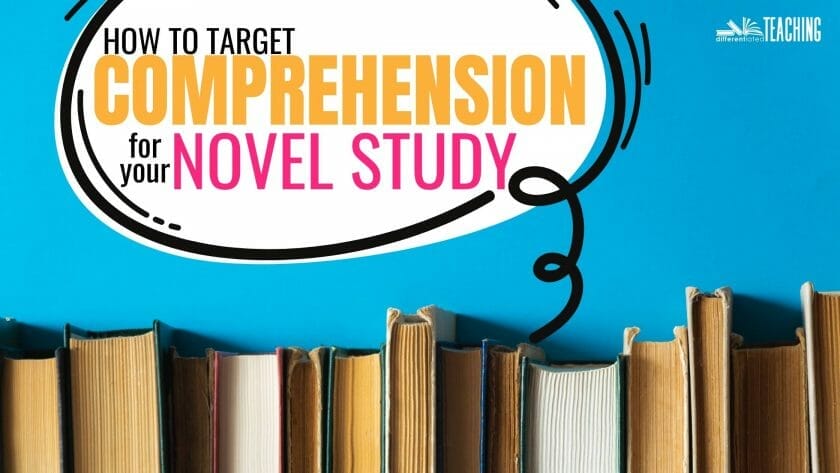
The great news is that you’ve already created a list of reading comprehension standards your students need to work on. (Typically, these are the higher-order thinking skills, like inferring and generating summaries, but it could be almost anything.)
You’ve also already read the book (or at least a good feel for it). That means you’re ready to start matching the standards with the plot of your novel(s).
(Note that if you haven’t read the text yet, you will likely need to do so as you work through the mapping process.)
As you start to read the novel, find natural breaking points that create approachable chunks of text for students to tackle in the time available. You’ll also pay attention to where your target standards fit within the breakdown. You’ll find that some parts of the book are better aligned to specific comprehension skills than others. This can be a huge help when planning your novel study activities.
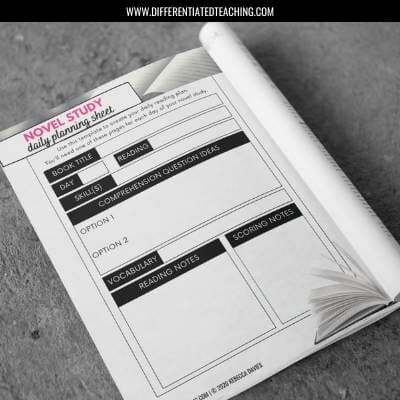
For example, you may find that one day’s reading contains numerous examples of cause-and-effect relationships, so you can select that standard to accompany the day’s lesson.
As you begin to plug your target standards into your plan, you’ll likely find some reading sections that could be matched with nearly any standard. I recommend leaving these for last. This lets you determine what skills you may not have included or have not been given adequate time for and assign them accordingly.
Once you’ve mapped out your target standards and filled in aligned skills for the remaining sections of the reading, you can write your daily comprehension focus in student-friendly language.
I add these to my calendar as the “Skill of the Day.”
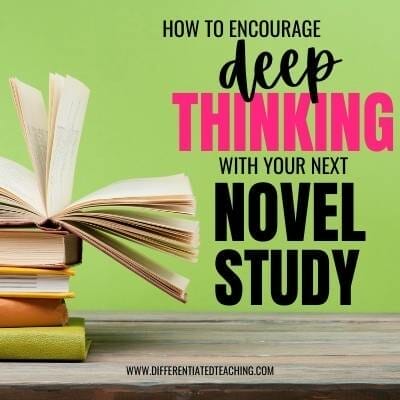
From there, I also generate a deep thinking question connected to the daily skill. (Although sometimes I draft these as I’m reading the chapters and assigning skills, this is the stage where I polish the questions.)
For example, I could ask students to identify the narrator and point of view of a story. This would adequately cover the standard in many grade levels.
However, my goal is to get students thinking, talking, and writing about their reading, and listing the narrator and point of view is a simple one-sentence answer.
As an alternative, I might ask students to explain how the narrator’s perspective impacts the reader’s understanding of the story. By doing this, I’ve pushed my students to identify the narrator and point of view while encouraging them to think about impacting their experience as readers.
Whether you’re working with children or adolescents, finding ways to build deep thinking and opportunities to share their own perspectives. At the same time, applying comprehension skills creates a richer, more meaningful, and much more engaging experience for learners.
Identifying Key Academic & Text-Based Vocabulary
After I’ve aligned all my comprehension skills, I like to take time to review the reading and select the text-based and academic vocabulary that will support my student’s understanding.
Since vocabulary can be a barrier to struggling learners, I aim to go deep rather than wide. This means my students may be exposed to a number of new vocabulary words, but they are only expected to master a handful each week.
For each day, I select one text-based vocabulary word that we work to break down and master. These are the terms you’ll explicitly teach as part of your novel study activities.
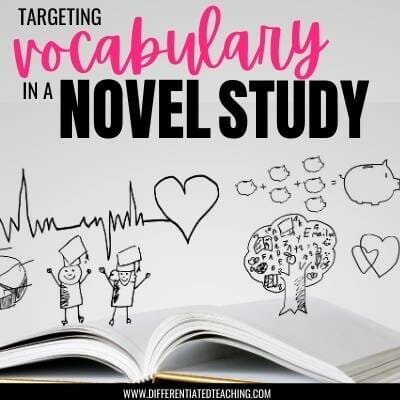
You may introduce context clues or dictionary skills. You may also teach students to analyze figurative language for vocabulary building.
Regardless of the strategies you teach, you’ll also want to consider having students define the word in their own terms, create a nonlinguistic representation, and hook the term (via synonyms and antonyms) to words they already know.
The main thing is to keep vocabulary instruction short and to the point.
In about 10 minutes, you can teach and find ways to apply most vocabulary words beyond the text…because we teach kids, not books (see the theme here?).
Consider Pre-Reading Hooks and Post-Reading Culminating Activities
Finally, you’ll want to consider how you’ll introduce and wrap up your novel unit. You’ll also want to consider any tech tools or websites that may help you do this.
Depending on students’ familiarity with the book(s) or topics you’ve chosen, you may find it beneficial to do some pre-reading novel study activities to create links to background knowledge and activate schema. I’ve shared some of my favorite ideas here: Pre-Reading Activities for your Novel Unit.
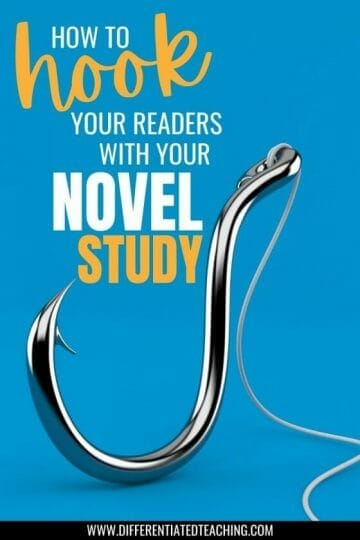
For younger learners or books set in unfamiliar periods, this may include reading some nonfiction books or watching informational videos.
Adolescents may read related newspaper or journal articles to help them build the foundational understanding.
Regardless of what you select, be sure that the material offers a hook that students can connect to their reading and is a purposeful use of class time.
You may also want students to share their learning to wrap up your novel unit. This can be especially powerful when students read different books than their peers.
Projects and group discussions are both common ways students are asked to share their experiences. However, many others exist and might be a better fit. Finding an engaging post-novel activity doesn’t have to mean tons of prep or a boring book report. There are so many other great post-novel activities that your readers will actually enjoy!
No matter what you choose, be sure to consider how you’ll differentiate and make sure you’re using instructional time effectively.
Preparing to Teach Your Novel Study Unit
You’ve done it! Your novel study unit plan is complete. You’ve decided what you’ll teach, how you’ll structure the lessons, and how long it will take.
As you prepare to start teaching your unit, consider how often you’ll review and score literature responses. You might also spend some time teaching students a specific strategy for constructed responses, like the RACE writing strategy.
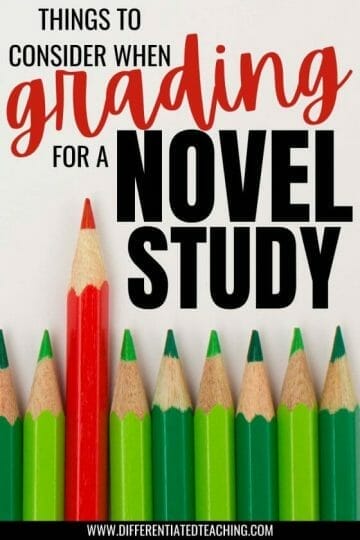
Try to be realistic. If you don’t truly feel you’ll be able to read 25 journals every day, be sure your unit’s effectiveness doesn’t depend on you doing that. (Although it can help to take a quick look daily to ensure students are on the general right track or whether adjustments may be needed.)
Creating rubrics with key expectations can be a helpful tool to make the assessment process more objective and simplify things for students. You can customize these depending on the skill being addressed or find a consistent rubric that you may use throughout the novel study.
No matter what you decide to do, NO WHOLE BOOK ASSESSMENTS!
Seriously, if we’re really teaching KIDS, not books, there is no value in doing a test over the book.
Once you’ve got those things in place, you’re ready to get started!
Get the Free Novel Unit Planning Roadmap
If you’ve made it this far and would like the templates to start planning your first novel study, here’s one more chance to do so!






